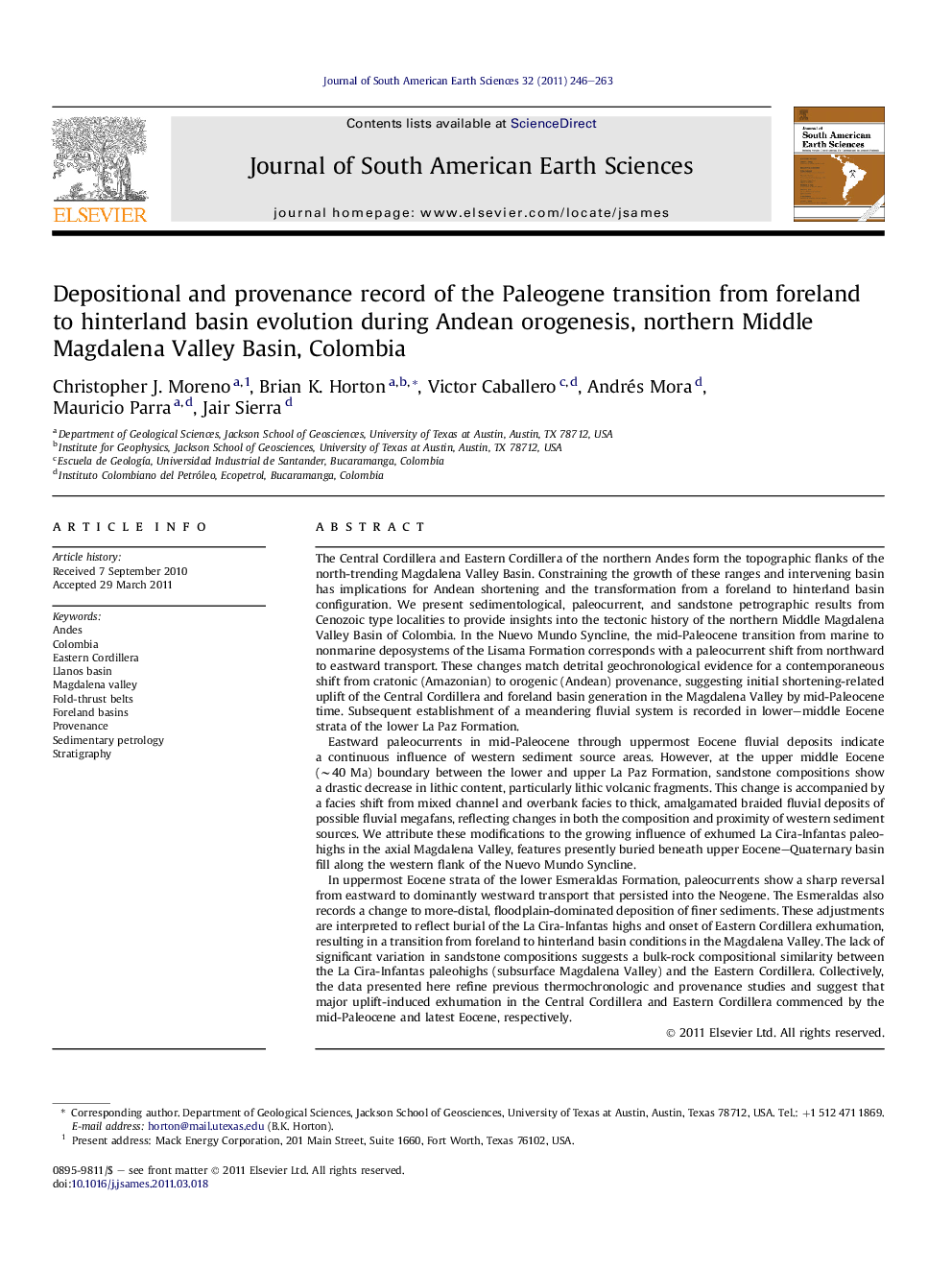| کد مقاله | کد نشریه | سال انتشار | مقاله انگلیسی | نسخه تمام متن |
|---|---|---|---|---|
| 4682584 | 1348928 | 2011 | 18 صفحه PDF | دانلود رایگان |

The Central Cordillera and Eastern Cordillera of the northern Andes form the topographic flanks of the north-trending Magdalena Valley Basin. Constraining the growth of these ranges and intervening basin has implications for Andean shortening and the transformation from a foreland to hinterland basin configuration. We present sedimentological, paleocurrent, and sandstone petrographic results from Cenozoic type localities to provide insights into the tectonic history of the northern Middle Magdalena Valley Basin of Colombia. In the Nuevo Mundo Syncline, the mid-Paleocene transition from marine to nonmarine deposystems of the Lisama Formation corresponds with a paleocurrent shift from northward to eastward transport. These changes match detrital geochronological evidence for a contemporaneous shift from cratonic (Amazonian) to orogenic (Andean) provenance, suggesting initial shortening-related uplift of the Central Cordillera and foreland basin generation in the Magdalena Valley by mid-Paleocene time. Subsequent establishment of a meandering fluvial system is recorded in lower–middle Eocene strata of the lower La Paz Formation.Eastward paleocurrents in mid-Paleocene through uppermost Eocene fluvial deposits indicate a continuous influence of western sediment source areas. However, at the upper middle Eocene (∼40 Ma) boundary between the lower and upper La Paz Formation, sandstone compositions show a drastic decrease in lithic content, particularly lithic volcanic fragments. This change is accompanied by a facies shift from mixed channel and overbank facies to thick, amalgamated braided fluvial deposits of possible fluvial megafans, reflecting changes in both the composition and proximity of western sediment sources. We attribute these modifications to the growing influence of exhumed La Cira-Infantas paleohighs in the axial Magdalena Valley, features presently buried beneath upper Eocene–Quaternary basin fill along the western flank of the Nuevo Mundo Syncline.In uppermost Eocene strata of the lower Esmeraldas Formation, paleocurrents show a sharp reversal from eastward to dominantly westward transport that persisted into the Neogene. The Esmeraldas also records a change to more-distal, floodplain-dominated deposition of finer sediments. These adjustments are interpreted to reflect burial of the La Cira-Infantas highs and onset of Eastern Cordillera exhumation, resulting in a transition from foreland to hinterland basin conditions in the Magdalena Valley. The lack of significant variation in sandstone compositions suggests a bulk-rock compositional similarity between the La Cira-Infantas paleohighs (subsurface Magdalena Valley) and the Eastern Cordillera. Collectively, the data presented here refine previous thermochronologic and provenance studies and suggest that major uplift-induced exhumation in the Central Cordillera and Eastern Cordillera commenced by the mid-Paleocene and latest Eocene, respectively.
► Paleogene strata record distal foreland to proximal hinterland basin conditions.
► Cenozoic evolution from marginal marine to meandering and braided fluvial systems.
► Provenance shifts record initial uplift of fold-thrust structures to east and west.
► A mid-Paleocene provenance reversal records initial Central Cordillera uplift.
► A late Eocene provenance reversal records initial Eastern Cordillera uplift.
Journal: Journal of South American Earth Sciences - Volume 32, Issue 3, October 2011, Pages 246–263